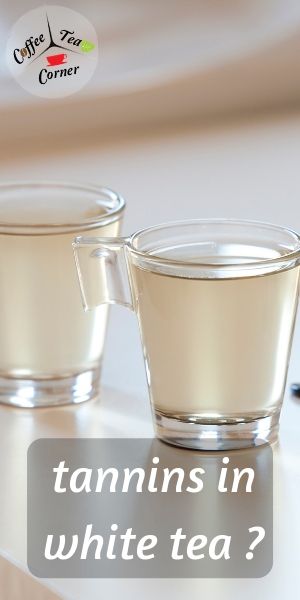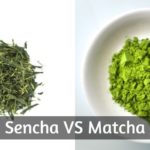Are you looking at the tannin content in tea ? It's wise to know what you're drinking and eating, so wondering about whether white tea has tannins or not is a valid question.
Let's see if there are any, and how that matters.

Table of Contents
So does white tea have tannins ?
White tea has the lowest tannin count. This is a tea that is minimally processed, so it will have a very low tannin level.
By comparison black tea has the highest tannin count, with green tea next and white tea last.
Any sort of roasting or firing of the tea buds and leaves will heighten the tannin levels. Usually, white tea is just picked, and then dried. Very little processing is applied to white tea.
So, white tea is a very low to no tannin type of tea. Let's see why that is, in a bit more detail.
What are tannins in tea ?
Tannins are a type of polyphenols. These are found in any and all teas made from the Camellia sinensis or Assamica plant, and as such they might be found in a small amount in white tea as well.
Polyphenols are responsible to flavor and astringence, and they contain a wide array of antioxidants.
The fresh tea leaves, that haven't been processed or have been barely processed at all contain cathecins.
These are antioxidants, and they produce a bitter astringence that you'll find in every green tea ever.
Once cathecins become oxidized, through processing like in black tea, they change their properties a bit and become tannins.
They still retain their bitterness, but aren't as astringent as cathecins.
Tannins also dictate color, usually imparting an amber/dark orange hue to whatever they're in.
For example, black tea is high in tannins. This is the main reason black tea is such a dark tea.
Not all heavily tannic teas are dark colored, but most often they are.
By this logic, you can see that white tea is low in tannins, as it's a very pale tea, often producing a pale gold color.
Figuring out if white tea has tannins, at a glance
You'll need to look at the color of the brew, and see which how dark it is.
White tea is a very light brew, sometimes barely colored. When it does show a bit of color, it's a very pale gold color.
This could be from the cathecins in white tea.
Some other teas can have a dark color, and still be low in tannins, so a taste test should also provide you with a clearer notion of how tannic the tea is.
You'll notice, in taste, that tannic teas resemble dry red wine. Tangy, a bit bitter, not very harsh but not exactly smooth either.
A tea high in tannins will also have a stronger body, and a more definite mouthfeel.
White tea is weaker and a bit watery, compared to every other tea available, so that's another way to figure out that it's low in tannins.
You can also look at the tea you have, and how its leaves have been processed.
For example the longer the oxidation process, the more chances there are that the tea is high in tannins.
This means black teas are almost always high in tannins, especially the Assam varieties.
White teas are on the other end of the spectrum, often not being processed at all by fire.
They are usually just dried, and as such the cathecins don't really oxidize.
So you can look for 3 things:
- the color of the brew
- how the tea leaves were processed
- the tea's body/mouthfeel, if it's watery or strong
(If you like this article so far, you can pin it to your Pinterest board by clicking the image below. The article continues after the image.)
Why white tea is low in tannins
Or why it possibly has no tannins to speak of.
You see, tea is harvested year round. The tea plant grows, and its leaves go from bud and young offshoot, to young leaves, and then adult leaves.
White tea uses tips, buds, and young shoots to brew.
The cathecins aren't really very present in the white tea, as the leaves aren't fully formed yet.
This might explain why white tea has very little tannins, since it might have a lower amount of cathecins in the first place.
Of course, this varies from one tea brand to the next, what kind of leaves/buds they use, where they get them from, how the tea plant was grown, and so on.
Do all teas have tannins ?
Most teas have tannins.
Calculating the exact amount of tannins in each tea type is not possible, but generally the more processed the tea leaves, the higher tannin count there will be.
This puts white tea on the low end, and black tea on the high end. Some white teas might possibly have no tannins at all, but instead retain some cathecins.
Between white tea and black tea, all other teas contain tannins.
So oolong, green tea, Pu'erh tea, all contain some amount of tannins.
How much tannins you get in your cup depends on how long you steep the tea leaves.
If you want to be sure your white tea has as little tannins as possible, you will need to let it steep for a short amount of time.
The longer you let the tea steep, the more tannins will be present in your cup.
This includes white tea, as it can get a bit bitter if you leave it too much, or use water too hot.
Most of the tannins will be gone with the first steeping, and as such the second cup will be smoother, but less flavorful.
Final thoughts
White tea is a bit uncommon in the West, since it's not something most of us drink.
Black and green etas are more prevalent, but white tea is beautiful and delicate in its own way.
It's one of the most delicate teas out there, rivaled only by how fussy green tea is to brew.
Usually tannins are alright, if taken in moderation. It's good to know the general levels of each tea.
If you want to know more about coffee or tea, feel free to check the related articles below. Who knows what else you might find ?





